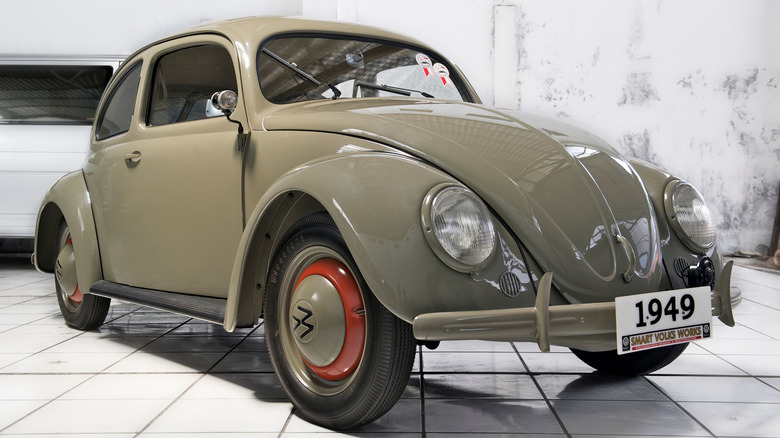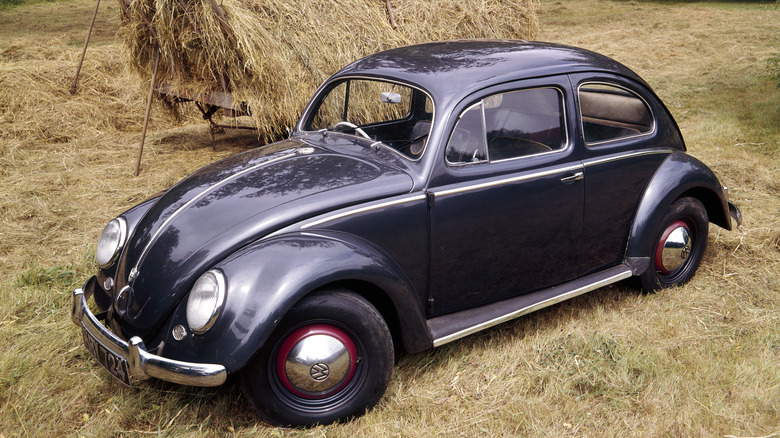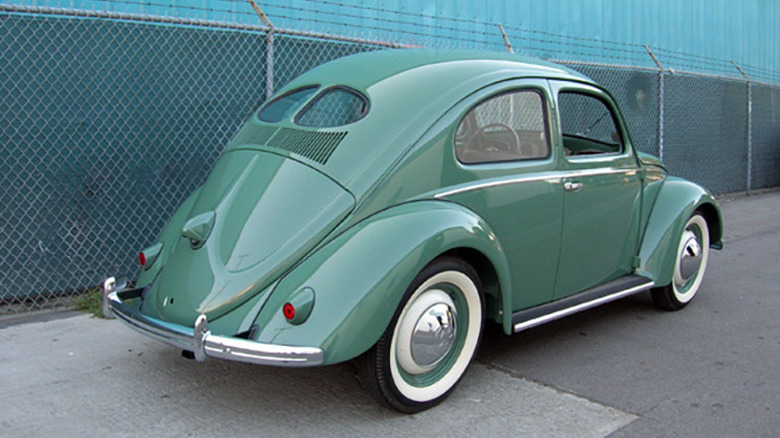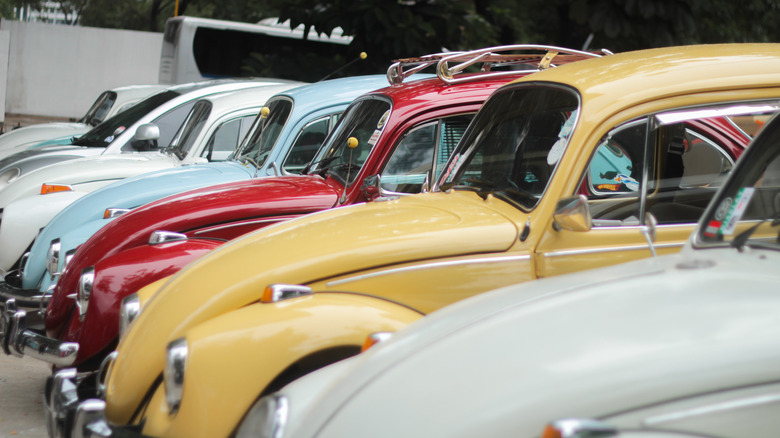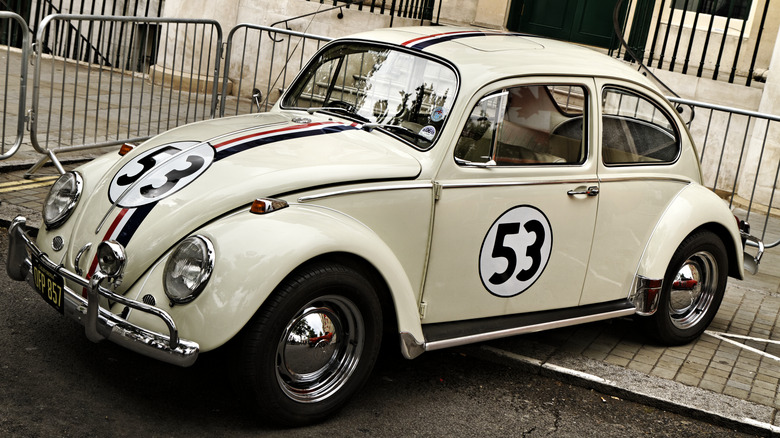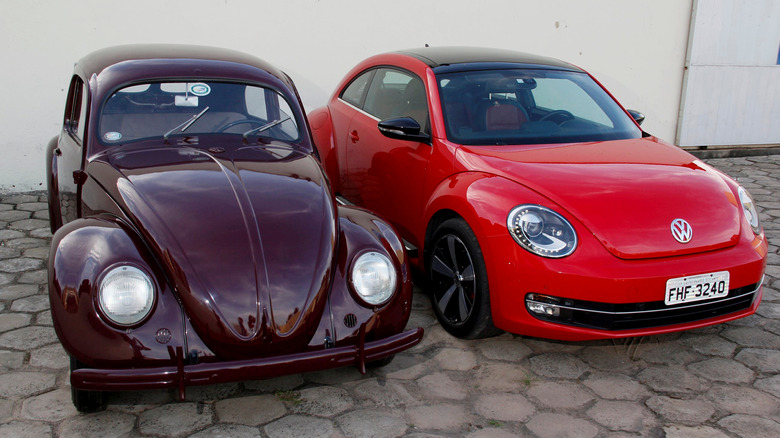German Invasion: Remembering The First Volkswagen Beetle Sold In The U.S
Volkswagen has ranked as the world's second-best selling automaker for three years running, trailing only Toyota with between 8.2 million and 9.3 million vehicles sold each year between 2020 and 2022. The Volkswagen group now includes 10 European brands including Porsche, Audi, Lamborghini, Bentley, and Ducati. However, the company almost didn't survive World War II. The auto group got its start and name from Adolf Hitler in May of 1937. He wanted a "people's car" and enlisted Ferdinand Porsche to design the brand's first model. In 1938, Hitler established the city of Stadt des KdF-Wagens ("City of the KdF Wagon"), now called Wolfsburg, which was home to the Volkswagen factory there.
During the war, the factory was used to make bombs and military vehicles. When the plant was captured by Allied forces in April of 1945, nearly 8,000 forced laborers were freed. The damaged factory and city were then handed over to the British after U.S. troops withdrew following Hitler's suicide and Germany's surrender.
Ford turned down the chance to acquire Volkswagen for free
British Maj. Ivan Hirst took command of the factory and convinced his superiors that Vollkswagens would work well as light transport. The British Army then responded with an order of 20,000 vehicles — including 1,785 Type Is — in 1945.
The Type I was the car eventually dubbed the Beetle. It would become the most-produced model in automotive history, surpassing the Ford Model T in 1972. According to Autoweek, the Brits found the Type I obnoxious and "quite unattractive to the average motorcar buyer." They even tried to give Volkswagen away to Ford, but Ford's board chairman Ernest Breech declined, saying, "I don't think what we're being offered here is worth a damn!"
At the time he may have been correct, as Volkswagen's assets included a single bombed factory and a product line featuring an underpowered car, but 78 years and 15 million Beetles later his folly is evident.
The Type I came to America in 1949
It wasn't until four years after the war's end that the first Type I Beetle made its way to North America, thanks to Dutch importer Ben Pon. He brought the first Beetles across the Atlantic in January of 1949 and drove one of them fruitlessly up and down the Eastern Seaboard, looking for a buyer, eventually selling it for $800 to help pay off a hotel bill. By the year's end, however, he had only sold two of the vehicles that reporters dubbed "Hitler's car," which Pon tried to re-label as the "Victory Wagon."
Pon returned to Europe, and importer Max Hoffman stepped in as the first official stateside Volkswagen dealer. Hoffman earned the exclusive right to sell Volkswagens east of the Mississippi, and by 1960 he had placed 300,000 American buyers behind their wheels.
[Featured Image by Jack de Nijs via Wikimedia Commons |Cropped and Scaled | CC-By Public Domain]
The Beetle became a big hit quickly
By that point, the Volkswagen product line had expanded to include the Transporter van and the Kharmann Ghia sport coupe. Volkswagen also hired the ad agency Doyle Dane Bernbach to help boost sales. DDB came up with the "Think Small" campaign, which Ad Age named the greatest advertising campaign of the century in 1999.
DDB's print ads featured a small photo of the Beetle on negative space, with a few paragraphs of text outlining the benefits of owning a smaller car that ended with a suggestion of "think it over."
Ad Age's Bob Garfield pointed out that the campaign was a perfect match for the Beetle's unassuming design, writing, "The rounded fenders were, in effect, the biggest tail fins of all, for what Volkswagen sold with its seductive, disarming candor was nothing more lofty than conspicuously inconspicuous consumption. Beetle ownership allowed you to show off that you didn't need to show off."
The Beetle was also a movie and TV star
Disney took advantage of the Beetle's popularity and unique style, making it the star of the 1969 film "Herbie the Love Bug," along with several movie sequels and a 1982 television series.
According to the Disney website D23, writer and producer Bill Walsh conducted a multi-car audition to select the right car to star as Herbie. "As the employees passed by on their way to lunch," Walsh said, "they looked at the little cars, kicked the tires, and turned the steering wheels. But everybody who went by patted the Volkswagen. The VW had a personality of its own that reached out and embraced people."
The oldest of the Beetles used in the film is now owned by a Texan named Clayton Capps, who runs an Instagram account for the car he calls "Herbie Number 10." The Beetle's unmistakeable design can also be seen in hundreds of other movies and television series, from "Beavis & Butthead" to "Grey's Anatomy."
The Beetle's run ended in 2019
By 1974, Volkswagen had moved production of the Beetle from Wolfsburg to its new plants in Mexico and Brazil, and, beginning in 1977, only sold the Type I Beetle in the U.S. in convertible form. Throughout the 1970s, the Type I gradually grew more powerful and driver-friendly, getting a larger windshield, automatic transmission, and electronic fuel injection.
Volkswagen introduced the New Beetle in 1998, with the familiar rounded shape but proper 20th-century features like a sunroof, air bags, and a turbocharger. While the early New Beetles had these modern features, VW tried to maintain the link to the car's hippie roots by including a flower vase as a dealer accessory. Car and Driver clocked the 1999 New Beetle as capable of going from zero to 60 in 7.3 seconds.
The last Type I came off the assembly line in Mexico in 2003, and the new version of the Beetle saw several updates and revisions before it was finally dropped for good in 2019.
